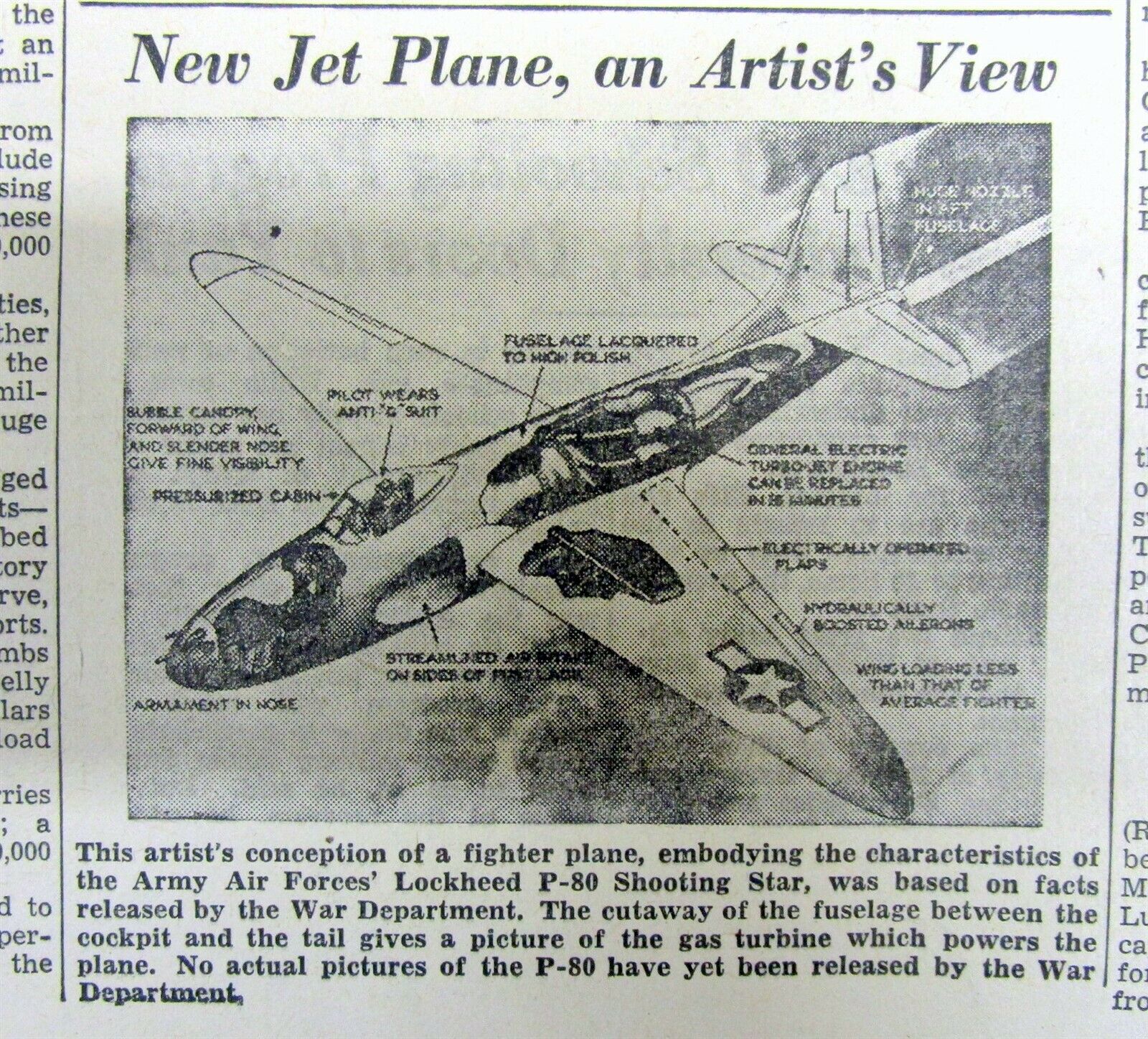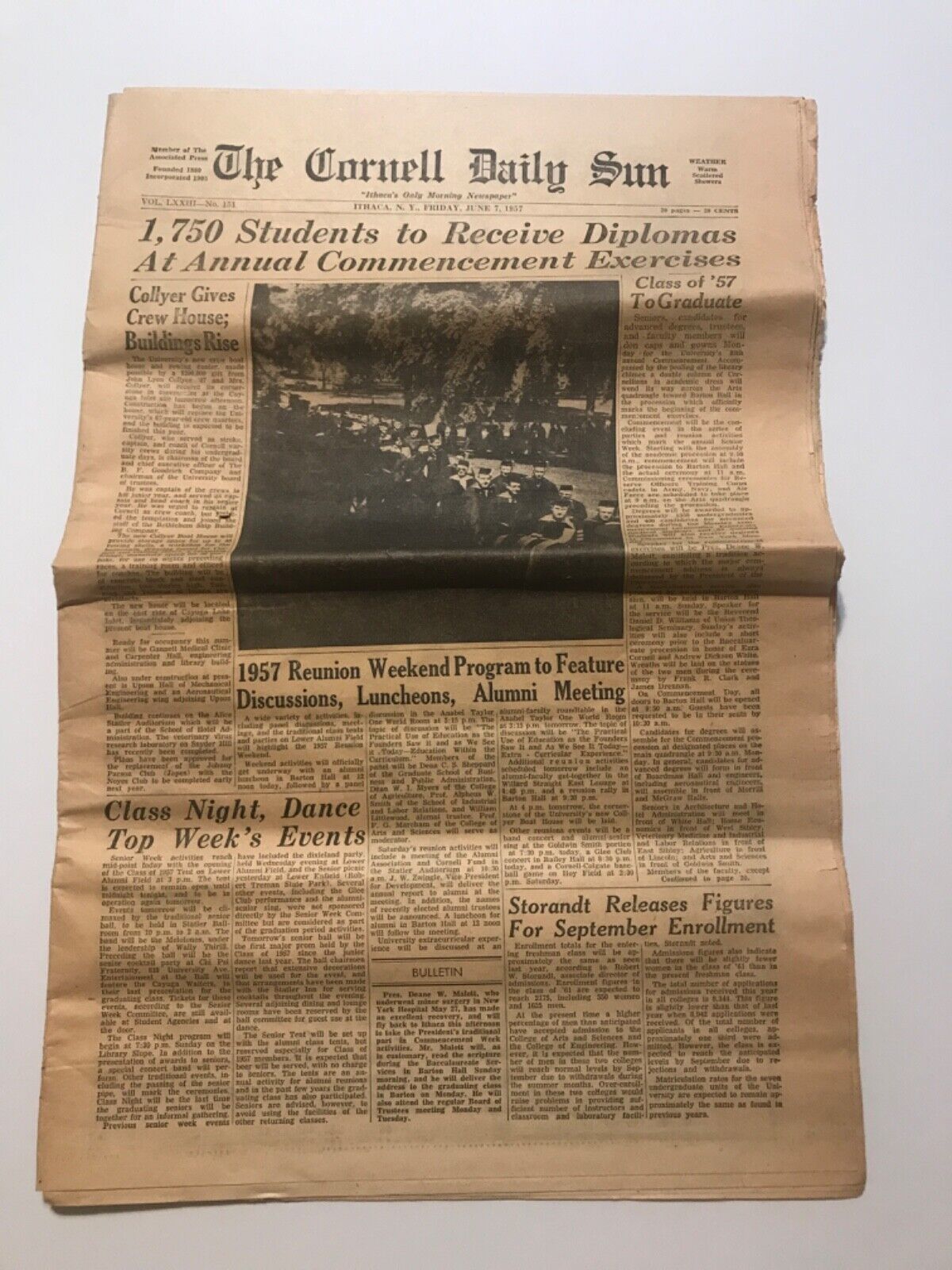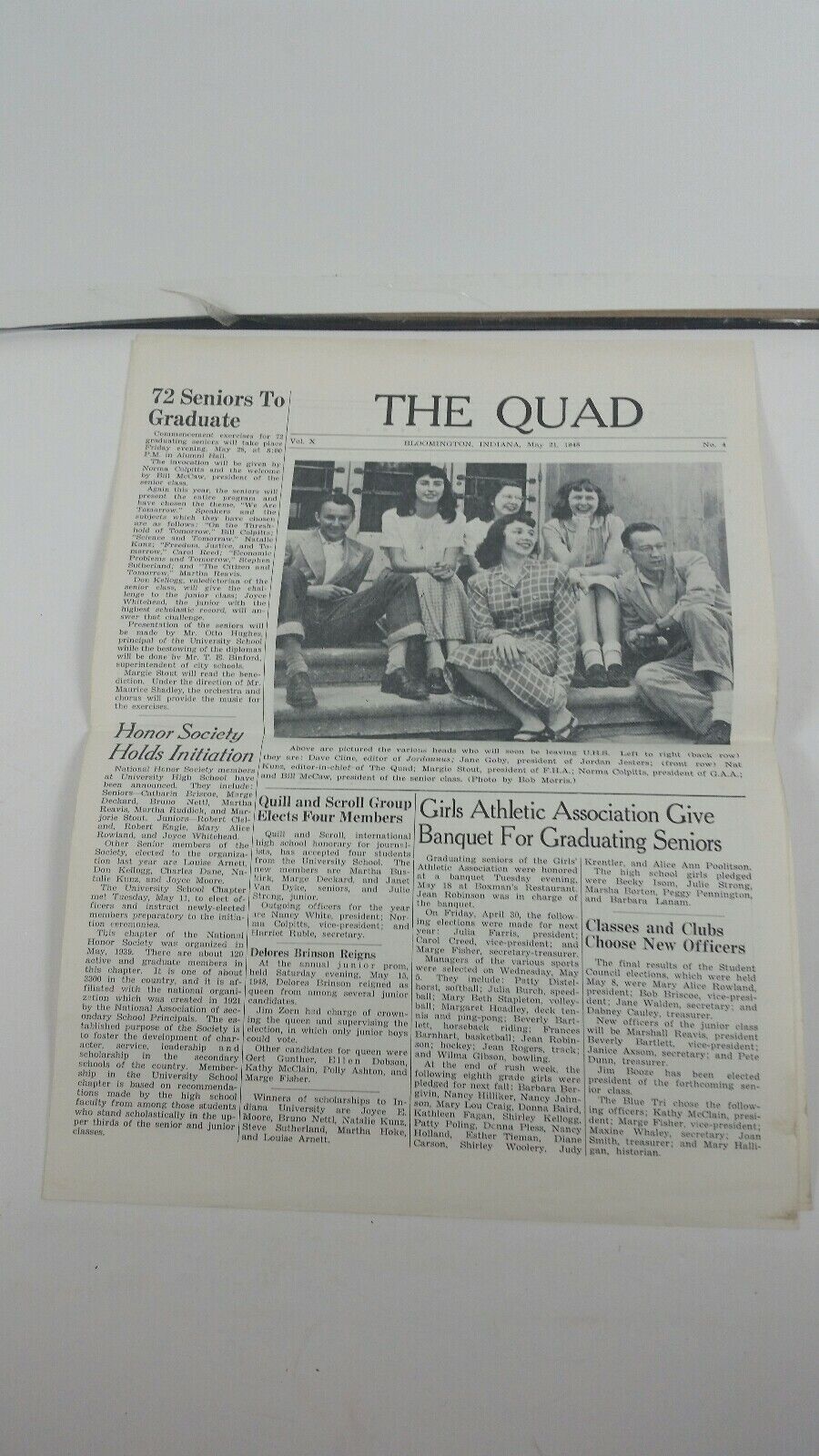-40%
1945 States & Stripes WW II newspaper w 1st view The new US JET FIGHTER WARPLANE
$ 15.83
- Description
- Size Guide
Description
1945 States & Stripes WW II newspaper w 1st view The new US JET FIGHTER WARPLANE1945
States & Stripes
WW II newspaper with a 1st view of the new US JET FIGHTER WARPLANE, the P-80 "Shooting Star"
- inv # 5P-243
Please visit our
EBAY STORE
for THOUSANDS MORE HISTORICAL NEWSPAPERS for SALE or at auction
SEE PHOTO(s)----- COMPLETE ORIGINAL American WW II era Armed Forces newspaper, the
Stars and Stripes
dated June 6, 1945.
This issue contains an inside page, 4" x 4" artist's view of the "NEW JET PLANE" of the US, the P-80 "Shooting Star".
The Lockheed P-80 Shooting Star was the first jet fighter used operationally by the United States Army Air Forces (USAAF). Designed and built by Lockheed in 1943 and delivered just 143 days from the start of the design process, production models were flying, and two pre-production models did see very limited service in Italy just before the end of World War II. Designed with straight wings, the type saw extensive combat in Korea with the United States Air Force (USAF) as the F-80.
The impetus for development of the P-80 was the discovery by Allied intelligence of the Me 262 in spring 1943, which had made only test flights of its own first quartet (the V1 through V4 airframes) of design prototypes at that time, all fitted with retracting tailwheel landing gear. After receiving documents and blueprints comprising years of British jet aircraft research, the commanding General of the Army Air Forces, Henry H. Arnold, believed an airframe developed to accept the British-made Halford H-1 B jet engine could provide the superior performance to match the new German jets, and the Materiel Command's Wright Field research and development division tasked Lockheed to design the aircraft based on their experience with the L-133. Concept work began on the XP-80 in May 1943. Since the British turbojet was not yet delivered, Lockheed obtained its blueprint dimensions from Bell as ordered by the USAAC. Lockheed's team, consisting of 28 engineers, was led by Clarence L. "Kelly" Johnson in the same manner as the P-38 Lightning, in the same remote building with high security and greater autonomy, a continuation of Lockheed's Skunk Works style of research and development.
With the Germans and British clearly far ahead in development, Lockheed was pressed to develop a comparable jet in as short a time as possible. Kelly Johnson submitted a design proposal in mid-June and promised that the prototype would be ready for testing in 180 days. The Skunk Works team, beginning 26 June 1943, produced the airframe in 143 days, delivering it to Muroc Army Airfield on 16 November.
The project was so secret that only five of the more than 130 people working on it knew that they were developing a jet aircraft, and the British engineer who delivered the Goblin engine was detained by the police because Lockheed officials could not vouch for him. After the engine had been mated to the airframe, foreign object damage during the first run-up destroyed the engine, which delayed the first flight until a second engine (the only other existing) could be delivered from Britain.
The first prototype was nicknamed Lulu-Belle (also known as "the Green Hornet" because of its paint scheme). Powered by the replacement Halford H1 taken from the prototype de Havilland Vampire jet fighter, it first flew on 8 January 1944, with Lockheed test pilot Milo Burcham at the controls. Following this flight, Johnson said, "It was a magnificent demonstration, our plane was a success – such a complete success that it had overcome the temporary advantage the Germans had gained from years of preliminary development on jet planes." The donated British jet program data had no doubt proved invaluable. In test flights, the XP-80 eventually reached a top speed of 502 mph at 20,480 ft, making it the first turbojet-powered USAAF aircraft to exceed 500 mph in level flight, following the August 1944 record flight of 502 mph by a special high-speed variant of the Republic P-47 Thunderbolt. Contemporary pilots, when transitioning to pioneering jets like the Shooting Star, were unused to flying at high speed without a loud reciprocating engine and had to learn to rely on the airspeed indicator.
In World War II, the
Stars and Stripes
newspaper was printed in several editions in several operating theaters. Both newspapermen in uniform and young soldiers, some of whom would later become important journalists, filled the staffs and showed zeal and talent in publishing and delivering the paper on time. Some of the editions were assembled and printed very close to the front in order to get the latest information to the most troops. Also, during the war, the newspaper published the 53-book series G.I. Stories.
The newspaper was the main printed source of news at the installations in Europe and Mideast and East Asia. Stars and Stripes has expanded to an average of 40–48 pages each day and is still published in tabloid format, reminiscent of many British dailies. The newspaper employs civilian reporters, and U.S. military senior noncommissioned officers as reporters, at a number of locations around the world.
After Bill Mauldin did his popular "Willie and Joe" cartoons for the WWII Stars and Stripes, he returned home for a successful career as an editorial cartoonist and two-time winner of the Pulitzer Prize. Former Stars and Stripes staffers also include 60 Minutes’ Andy Rooney and Steve Kroft, songwriter and author Shel Silverstein, comic book illustrator Tom Sutton, author and television news correspondent Tony Zappone, cartoonist Vernon Grant (A Monster Is Loose in Tokyo), Hollywood photographer Phil Stern and the late stock market reporter and host of public television's Wall Street Week, Louis Rukeyser.
Very good condition. This listing includes the complete entire original newspaper, NOT just a clipping or a page of it. STEPHEN A. GOLDMAN HISTORICAL NEWSPAPERS stands behind all of the items that we sell with a no questions asked, money back guarantee. Every item we sell is an original newspaper printed on the date indicated at the beginning of its description. U.S. buyers pay priority mail postage which includes waterproof plastic and a heavy cardboard flat to protect the purchased item from damage in the mail. Upon request by the buyer, we can ship by USPS Media Mail to reduce postage cost; however, please be aware that USPS Media Mail can be very slow in its time of transit to the buyer. International postage is quoted when we are informed as to where the package is to be sent. We do combine postage (to reduce postage costs) for multiple purchases sent in the same package.
We list thousands of rare newspapers with dates from 1570 through 2004 on Ebay each week. This is truly SIX CENTURIES OF HISTORY that YOU CAN OWN!
Stephen A. Goldman Historical Newspapers has been in the business of buying and selling historical newspapers for over 50 years. Dr. Goldman is a consultant to the Freedom Forum Newseum and a member of the American Antiquarian Society. You can buy with confidence from us, knowing that we stand behind all of our historical items with a 100% money back guarantee. Let our 50+ years of experience work for YOU ! We have hundreds of thousands of historical newspapers (and their very early precursors) for sale.
Stephen A. Goldman Historical Newspapers
has been in the business of buying and selling historical newspapers for over 50 years. We are located in the charming Maryland Eastern Shore town of OXFORD, Maryland.
Dr. Goldman is a consultant to the Freedom Forum Newseum and a member of the American Antiquarian Society. You can buy with confidence from us, knowing that we stand behind all of our historical items with a 100% money back guarantee. Let our 50+ years of experience work for YOU ! We have hundreds of thousands of historical newspapers (and their very early precursors) for sale.
We invite customer requests for historical newspapers that are not yet located in our extensive Ebay listing of items. With an inventory of nearly a million historical newspapers (and their early precursors) we are likely have just the one
YOU
are searching for.
WE ARE ALSO ACTIVE BUYERS OF HISTORICAL NEWSPAPERS, including large and small personal collections, bound volumes, significant individual issues, or deaccessions from libraries and historical societies. IF YOU WANT TO SELL, WE WANT TO BUY !!!
Powered by SixBit's eCommerce Solution










